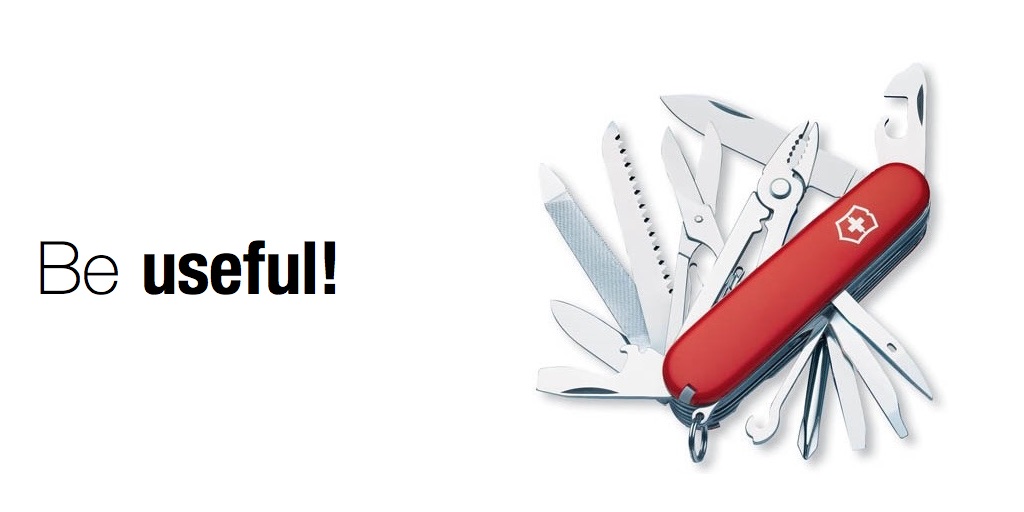The minimalist guide to social media marketing
As a coach, consultant, freelancer or business owner you understand the need to not only hold the attention of your prospective customers.
You have to actually drive them to take action. Not just once but continuously.
If you read and implement the practical principles in this post, you will start seeing amazing results that will transform your business.
The minimalist guide to social media marketing
1. Be focused
Before you start out at all, it is important that you clarify your goals. When I talk about goals, I’m not talking about social media goals like increasing likes and getting more followers.
I’m talking about business goals like generating leads or establishing yourself as an expert in your industry.
Your goal is not to become a social media superstar. Your goal is to become a business genius because of how well you harness social media to achieve your business objectives.
Your focus should be on how to translate your social media assets to practical business growth
Are you looking to create awareness, humanise your brand, introduce a new product, offer customer service, increase your sales or garner support for a cause?
Your destination will determine the route that will get you there.
2. Choose your platforms for social media marketing
You don’t need to be active on all platforms; you only need to be on the ones that matter to you and your prospects. That’s the basis of social media marketing.
So, using the insights you got from the first step, determine the bare minimum social networks where you need to establish your presence.
Your choice will generally be based on how much time and resources you can devote to each platform and how well the platform suits your business goals especially in terms of ‘hosting’ your ideal clients.
You don’t need to be active on all platforms; you only need to be on the ones that matter to you and your prospects.
For a start, you should plan to invest at least one hour per day per social media platform. Apart from time, you should also consider your available resources.
For instance, before choosing to go with Pinterest, check if you have the capacity to generate infographics and other visual content.
If you’re considering YouTube, do you have the skills and resources for creating video content?
The point is to make sure you have what you need before diving in.
3. Optimise your profiles
Before you start posting content, take some time to thoughtfully, deliberately and completely fill out your profiles.
Ensure that your profile photos, cover images, bio and profile information are up-to-date, professional and consistent across your chosen platforms. For your profile picture, use a
For your profile picture, use a high-quality image, preferably your business logo or a professional headshot.
The most important thing about your bio is that it should reflect who you are, what you do, who you do it for, what those people want or need and how connecting with you will change or improve their lives.
It’s not a sales pitch. See it like a brief introduction that helps you get your feet in the door and make your target audience interested in connecting with you.
Make it personal and use keywords that suit your target audience.
4. Cultivate a distinctive voice and tone
No matter how good your social media plan is, without an effective content strategy, it’s like a car without fuel – it won’t get you anywhere.
The first thing you need to ask yourself when it’s about social media marketing is simple. What kind of content do you want to share on your social media platforms?
Now, as important as it is to have valuable text and visuals, content is a whole lot more than that.
The ‘spirit’ of your content is more important than the ‘letter’
In other words, it’s not just about what you say; it’s much more about how you say it. How do you want your customers to think about you and your business?
What kind of perception do you want to create? What feelings do you want to evoke when they relate to you?
Think about this and let it shape the voice and tone of your messages. The principle is to let your brand personality bleed through your content.

5. Deliver amazingly useful content
You must consistently share helpful content that provide your audience with lots of value. You can deliver content in a variety of formats including simple text posts, images, videos, links, quotes and reshares.
Rather than focusing on just one medium, use different types for variety. There’s overwhelming evidence that visual content gets a lot more views and engagement than plain text updates.
You can easily create graphic posts using tools like Canva or Pablo. Now, it’s easy to know all the right things to do. The real work – and the difficult part – is actually doing it consistently.
That’s why you need a content calendar to plan and schedule your posts. If content is the fuel that drives your social media marketing engine, your content calendar is the fuel dispenser – or maybe fuel storage tank.
You can use a simple spreadsheet or any of the tools available online. The important thing is to include a few essential components.
The social media account, the publish date and time, the type of content (article, video, photo, etc.), the actual post you plan to share, and any necessary media you’d like to go with it.
6. Automate routine tasks
Once you have done the hard work of planning and collecting your content, you should make things easier for yourself by automating routine tasks like posting content.
Tools like Hootsuite, Buffer, Crowdfire, Social Jukebox (formerly Tweet Jukebox) and other such tools make it easy to ‘drip’ content into your social media feeds.
That is, you can load up your social media accounts with content in advance and schedule the content to deliver at specified times or over a period of time.
This helps you to keep your social media timelines fresh and active without having to always fret about posting content.
If you have a self-hosted WordPress website, you can achieve this by using a plugin like Revive Old Post (formerly Tweet Old Post) or SNAP (Social Networks Auto-Poster).
I’ll sound a note of caution here. You must be smart in your automation and not let it look like a robot is managing your account.
7. Leverage the power of community
Jeff Goins makes many profound statements in his book, The Art of Work. Here’s one that particularly stands out to me:
Every story of success is, in fact, a story of the community
It is practically impossible to survive alone much less thrive in isolation. So, it is important that you forge real relationships with people.
And don’t do it for what you’ll get; do it for what you’ll give. It probably sounds counterintuitive but what you give will ultimately come back to you in multiple folds.
You cannot downplay the place of building high-quality relationships with influencers and other people in your field. You should also consider participating in groups and forums where your ideal clients hang out.
Join relevant groups on Facebook and LinkedIn. Participate in Google communities. Join Twitter chats in your areas of business interest. Eventually, you should also consider launching your own group.
A close-knit community gives you the opportunity to regularly engage with your ideal customers and bond with them. There you listen to them, solve their problems and provide them with valuable resources for free, long before ever asking for a sale.
8. Analyse and measure
Usually, you won’t get it right the first time. And even if you do, there will always be room for improvement. But you can only improve what you measure.
So you need to find out what’s working and what’s not so that you can do more of what’s working and redesign or discard what’s not.
What percentage of your referrals and website visitors are coming from social media? What posts are attracting the most engagement in terms of shares, retweets, clicks, likes, comments and replies?
Although these ‘vanity metrics’ (likes, followers etc.) have their value, they are not the most important statistics to look out for.
You should pay more attention to reaching, sign-ups and conversions, leads generated, website traffic and revenue generated.
The major social media platforms have their native analytics reporting systems that provide you with relevant data which you can then analyse and interpret in light of your overall objectives.
Another good idea is creating a custom reporting system using RSS feeds and tools like Google Analytics if you have a bit of tech savvy. Better still, you can opt for an easy-to-use social media dashboard like the ones offered by Hootsuite and Buffer.

9. Convert fans into friends and connections into customers
You don’t need any convincing that effective use of social media is a great way to grow your business – you already know that – otherwise, you wouldn’t come this far.
However, you must also realise that building your entire marketing and promotion strategy on social media is like building your house on shifting sand.
The social media marketing world is transient – things change every time. Many platforms that were the rave a couple decades ago are much less successful today.
Social media has come to stay, but the platforms and tools will continue to change. As a serious businessperson, you want to squeeze as much juice as you can from your social media investment.
The way to do this effectively over the long term is to consider social media marketing as a means to an end, not an end in itself
Use it to initiate relationships with your prospective customers and get them to give you their email addresses or some other means to connect with them more closely.
That way, you can be sure of being able to reach them when necessary. Social media platforms are an excellent way to create initial awareness, interest and desire.
But, eventually, you should get the prospect to take action either by buying your product/service or by joining your email list.
The most desirable goal would be to make the potential customer do business with you right away but you may not always be able to achieve that.
The next best thing is trying to get more information and securing permission for future interactions. This is one major boost that your email list provides for your marketing efforts.
10. Put your money where your mouth is
You’ve probably heard it said that “The best things are free”.It’s a popular statement but that does not make it true. Essential things may be free but the best things are not.
Every time you get a good thing for free, you should know that someone paid for it. The same principle applies to your social media efforts.
You can get started for free but if you want the best results, you’ll need to invest your resources. Especially time, effort and money.
You’ll need to subscribe to paid versions of social media management tools like Hootsuite, Buffer, Crowdfire or whichever one works for you. You’ll need to run adverts too.
Social media is not cheap as most people believe; it is actually expensive – in a different way.
You need money to run social media campaigns but you don’t need to have the marketing budget of Coca-Cola before you can make a significant impact on social media.
So, there you have it – a simple action plan to help you amplify your influence and generate a consistent stream of clients.
Social media strategy will vary from person to person and business to business, but the fundamentals are the same.
If you apply all you have learned in this solid guide, I guarantee that you will be elated with the outcome.
Did you find the article inspiring? Leave your opinion in the comments below and let us know. We’d love to hear from you!
For more finance and business tips, check our finance section and subscribe to our weekly newsletters.
The post The minimalist guide to social media marketing appeared first on AlphaGamma.
What Business Stars Say About Jon Flatt:

“I have witnessed firsthand Jon`s unique ability to lead and build a company from the ground up. He has a proven track record to create technology, operations and company vision based on identifying early adopter trends in the market place”, VP , Circuit of the Americas

“Jon Flatt is a true entrepreneur and pioneer in the fast growing world of online advertising. His philosophies on innovation and business operations in the new economy have proven to be very successful.”, Billionaire and former owner of , The Minnesota Vikings

“Jon has an uncanny ability to quickly understand very complex issues and come up with effective scaleable solutions. His abilities as a problem solver are among the best I have ever experienced”, CEO , Verdant Frontiers

“Jon Flatt is a visionary who has the unique ability to identify early adopter trends in online advertising and more importantly, develop and execute strategies to capitalize upon those trends.”, Partner , McCombs Enterprises

“Jon Flatt builds and leads profitable, highly successful, and rapid growth companies. He is able to focus on mentoring excellent leadership teams, attracting top talent, and gaining employee loyalty during an intense high growth revenue stage. Having worked as CFO for Jon's previous company, Lin Digital, I was able to see first hand his razor sharp focus on building a highly profitable business with an end goal to produce company, employee and shareholder returns.”, CFO , Nfluient

“With almost two decades of experience in digital advertising sales, business operations, and as a publisher, Jon brings a level of combined expertise not seen often in the digital space. Leveraging owned and paid assets for revenue and sales is tough. Building a business from that success is even more difficult. Few people exist that can help you accomplish those types of goals. Jon is one of them. ”, Director, Business Development , Varick Media Management

“Jon Flatt is a true visionary in the digital space. He's a born entrepreneur, leader, and always has his finger on the pulse of "whats next".”, Regional Account Executive , LIN Digital

“If you are looking to improve your company culture, attract the best talent and position your company for maximum growth, you need to be talking to Jon. Early on in the digital World, Jon realized that tech is an important component in the Red McCombs Media value proposition and while service is key, a tech platform would position the company far beyond competitors. He conceptualized and created RedZone, a platform that streamlines internal workflow that competitors are still trying to replicate in 2016 and gives full, real-time data access to agency clients and brands beyond the limitations of a DSP or an ad server. This is just one of many things that made Red McCombs Media attractive to bidders and led to the purchase of Red McCombs Media by LIN Media. With the powerful combination of tech and service touted by LIN Media, they were purchased by Media General, who was then purchased by NexStar. All of these companies achieved great success as a result of Jon’s early work…work which has withstood the test of time.”, regional account lead , Centro

